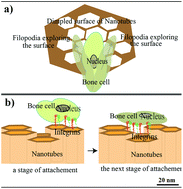Cell response and bioactivity of titania–zirconia–zirconium titanate nanotubes with different nanoscale topographies fabricated in a non-aqueous electrolyte
Abstract
The morphology and the physical and chemical characteristics of four groups of TiO2–ZrO2–ZrTiO4 nanotubes that were fabricated via anodization in a non-aqueous electrolyte were investigated in order to examine their influence on the bioactivity of, and cell adhesion on, Ti50Zr alloy. Scanning electron microscopy (SEM) and 3D profilometry were used for the characterization. The in vitro cell responses to nanotubular surfaces with different inner diameters (Di) between 25 and 49 nm were assessed using osteoblast cells (SaOS2). The results of the MTS assay indicated that the percentage of cell adhesion on the nanotubes was influenced by the nanoscale topographical parameters including the tube inner diameter (Di), the tube wall thickness (Wt), the amplitude roughness (Sa) and the spacing roughness (Sm) of the nanotubular surface. Cell adhesion was promoted to 84.9% on nanotubes with an inner diameter of 25 nm, or 80.3% on nanotubes with a large wall thickness of 34 nm due to the accelerated integrin clustering and focal contacts of formation. A nanotubular surface with a low spacing roughness of 33 nm3 nm−2 led to a cell adhesion of 61.0%. Similarly, a nanotubular surface with a high amplitude roughness of 1.03 μm revealed a cell adhesion of 61.5% in instances where the inner diameters (29 nm) and wall thicknesses (24 nm) were within the critical dimensional parameters for cells to survive and thrive.


 Please wait while we load your content...
Please wait while we load your content...